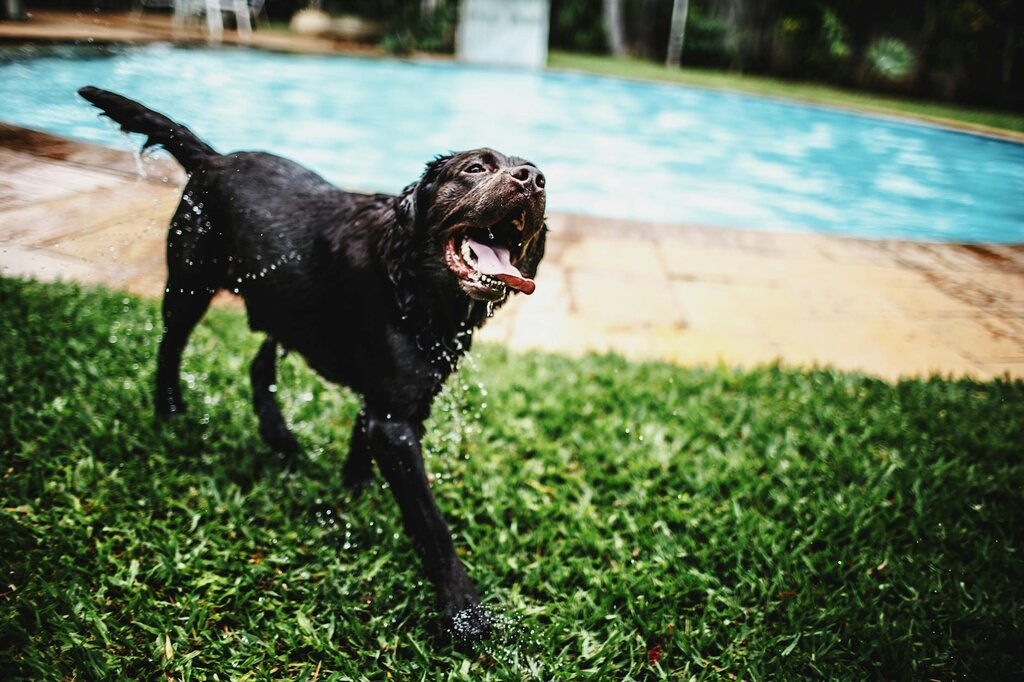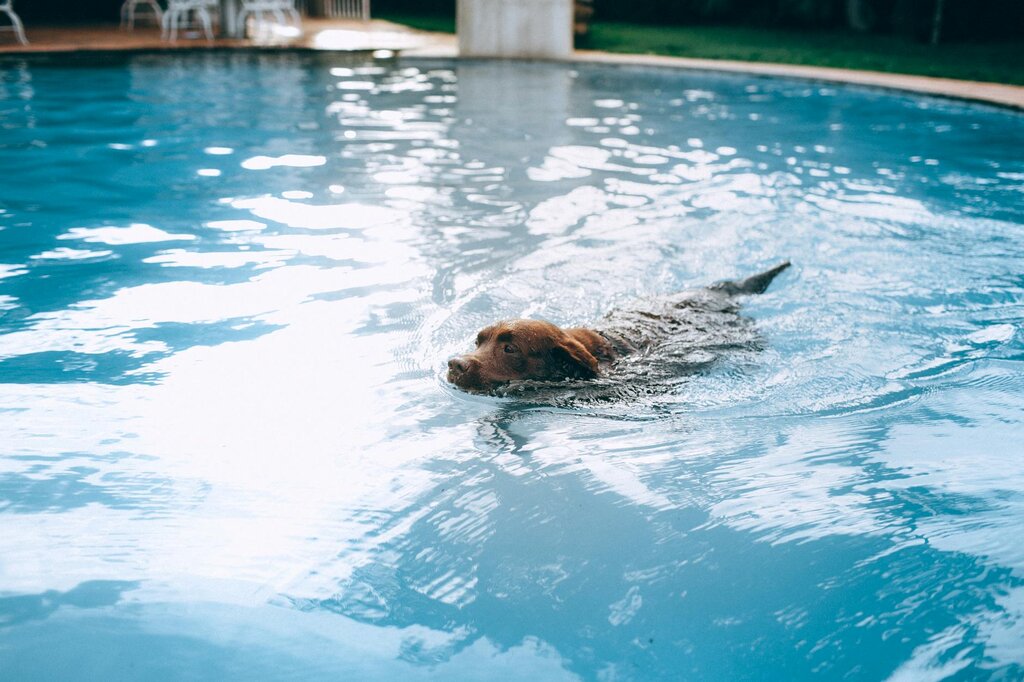Last Updated: 23/10/2025
How to Teach Your Dog to Swim Safely: A Vet's Guide
Learn how to teach your dog to swim safely with our expert vet's guide. Discover a step-by-step method, from using a paddling pool to moving to the big pool. Get positive training tips and essential advice on pool safety and life vests.
Author: Dr Gillian Hill BVSc (Hons)
Reading Time: 5 minutes - short read
Teaching your dog to swim is not just a great way to have fun with your pet in summer; it can also keep them safe if they ever fall into a pool or other body of water. Swimming is also excellent non-weight bearing exercise, so for those dogs who are overweight, or suffering from arthritis, it's a very safe form of activity.
What Dogs Like to Swim?

Some breeds like the Border Collie, Golden Retriever and Labrador Retriever can be impossible to keep out of the water! Other Retriever breeds along with Spaniels also tend to love the water.
Breeds such as the Leonberger and the Poodle, while not the typical breeds we may think of who love water, do tend to like swimming excursions too!
Can All Dogs Swim?
While certain breeds do love the water, other breeds and individual dogs may need a little more coaxing.
Some breeds simply weren't designed to be water wonders. Brachycephalic breeds like Pugs, Boxers or Bulldogs can have difficulty due to the structure of their airways while Dachshunds and Bloodhounds simply have the wrong body shape. Take caution with these breeds in exposing them to deep water though any dog, regardless of breed or swimming skill, should always be supervised around water.
For more information, read through our article on Swimming Safety for Dogs.
How to Teach a Dog to Swim

Start with an empty pool
To begin, we aren't even going to use water. Instead you'll need a kiddie pool or dog pool, treats, toys and your pooch! Get your dog used to being inside the empty pool and associate the object with positive thoughts by praising them, giving them treats and playing with them while in the pool.
Once your dog is happily settled in the pool, practice getting in and out of the pool on command. Use treats to reinforce the commands when they successfully step in and out of the pool. Once they have mastered this, you are ready to move to phase two!
NOTE: During training, limit each session to 3-5 minutes to prevent your dog from getting too fatigued or bored.
Add Water to the Pool
- Fill the pool with approximately 10 centimetres of water. If it's a cool day, consider adding some warm water to ensure your dog doesn't get too cold.
- Direct your dog into the water using the commands you have previously practiced. You may need to use a treat or a toy to entice them in at first.
- Toss floating treats, such as Lamb Puffs, into the water so your dog gets used to getting their snout wet.
- A paste on a spoon such as natural peanut butter or Kong Easy Treat Paste, is also a great option to tempt them into the water.
Gradually increase the depth
- Once your dog is readily jumping in and out of the pool on command and happily fetching treats or toys, you can add more water.
- Add the water in 5-10 centimetre increments and repeat the same positive exercises at each new level.
Moving to the big pool
- After your dog has reached the capacity of the kiddie pool, it's time to move on to a larger pool.
- Swimming pools are suitable, but avoid going straight to the beach or other bodies of water that may have strong currents.
- Be mindful of chlorine; it's best to put the treats away and use your dog's water toys as the incentive instead.
- Wear your swimming gear, as you'll most likely be getting in the water with your dog!
- Use the same command to ask your dog to jump or walk into the water as you did with the kiddie pool. Tossing your dog's toy into the water can give them a target.
- Alternatively, you can get in the pool first and hold out a toy to encourage them to follow.
- When your dog jumps into the water, immediately direct them back to the steps or ramp so they learn how to exit the pool safely.
- You can repeat this process a couple of times, depending on your dog's enthusiasm, before finishing the training session.
Dog Swim Vests
A doggy life jacket is a great tool while learning to swim as it allows you to easily manipulate your dog's direction and is their support as they learn how to use their paws in water.

Learning to Swim
Once your pooch is comfortable with jumping into the pool and knows how to get out, you can do some swimming lessons! Teaching your dog how to turn in water is the next step. When you are both in the pool, use a treat or toy, bring it close to your dog's face and slowly move it past the side of their face. This is easiest if you are able to stand and walk around your dog.
Make sure you let your dog get the treat or toy once they turn, first at 90 degrees, then 180 and 360. Remember to keep training sessions to 3-5 minutes to prevent your dog from fatiguing and panicking. Practice turning in both directions, this is a huge part of swimming and a lot of canines don't properly learn this skill.
Tips to remember
Keep training positive
- Keep swim sessions short to prevent your dog from becoming fatigued.
- Never force your dog to enter the water. The goal is to build confidence, so gradually lead them in using positive reinforcement like treats or toys.
- Throwing a dog into the water is dangerous and will likely create a lasting negative association and fear of swimming.
Pool safety essentials
- Your pet must be supervised at all times when swimming.
- Make sure your pool is properly secured or fenced so your dog cannot access it unsupervised.
- Consider investing in a ramp for your pool. This allows your pet a safe way to get out in the event they accidentally fall in.
- Don't let your pet drink chlorinated pool water. Always provide a bowl of fresh water nearby.
Teaching your dog to swim can be a fantastic way to bond, stay cool in summer, and provide excellent low-impact exercise.
The key to success is patience. By starting small in a paddle pool and using plenty of positive reinforcement, you can build your dog's confidence at their own pace. Remember to always keep lessons short and fun, and never force a nervous dog.
With consistent, positive training and a strong focus on safety - like constant supervision and a secure pool exit - you can help your furry friend become a happy, confident, and safe swimmer for life.
Articles recommended for you
Our vet authored guide to the benefits of feeding your dog fresh food plus tips and advice for introducing it into their regular menu.
See our guide to protecting your pet from parasites from our vet team.
Thinking of getting a fish? Check out our guide for setting up a tank and home care tips!
Looking to understand horse feeds better? This comprehensive guide covers feeding recommendations for horses of all ages and disciplines.
Does your pet suffer from anxiety? Check out our Vet-guide for treatment options to help your pet.
History
Our experts continually monitor the health and wellness space and we update our articles when new information becomes available.
Thu 23 Oct 2025
Edited by Dr Gillian Hill BVSc (Hons)Dr Gillian Hill BVSc (Hons)
Veterinarian
Dr. Gillian loves being able to provide depth and detail to pet parents questions, and give up to date, evidence based advice. She loves the variety of pets and inquiries she receives - she especially loves the 'curly' questions that require some research! Seeing the gorgeous photos that pet parents send through of their babies is a highlight of the day! Gillian enjoys to further her veterinary knowledge, and has completed further training in ultrasonography, behaviour and backyard poultry!

